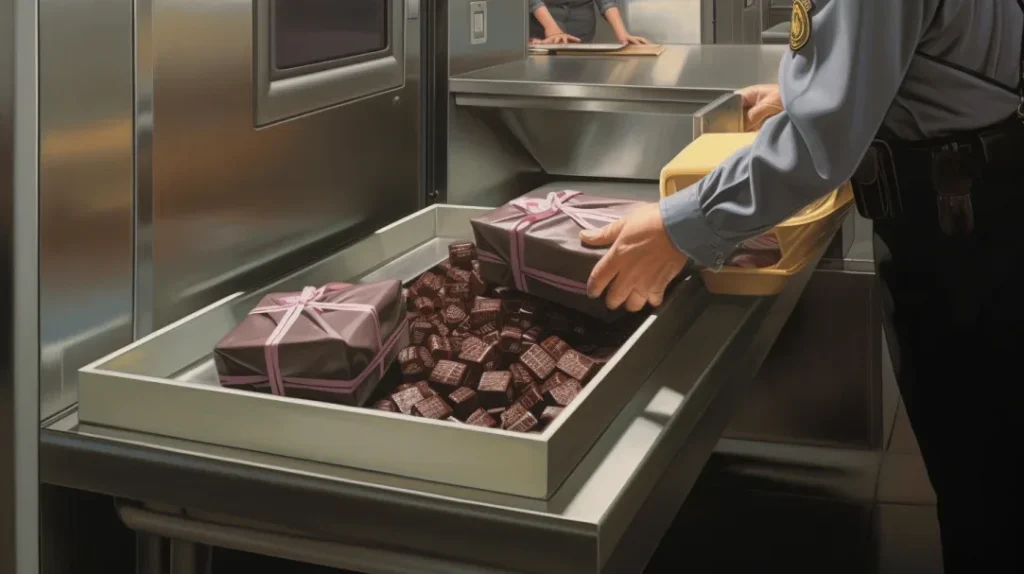Table of Contents
Do you have a sweet tooth and a flight coming up? Can you bring chocolate on a plane? Well, ‘sweet’ news for you! Navigating air travel with chocolate is easier than you might think.
TSA regulations allow you to bring chocolate on a plane, both in your carry-on and checked bags. Whether you’re a chocoholic or looking to gift some delicious treats, we’ve got you covered.
Follow simple rules and enjoy your favorite indulgence at 30,000 feet.
Key Takeaways Of “Can You Bring Chocolate On A Plane”
- According to TSA regulations, chocolate is allowed in both carry-on and checked bags.
- The liquid rule applies to chocolate in carry-on luggage – containers should be 3.4 ounces or less and placed in a clear, quart-sized bag.
- Solid chocolate, such as bars or truffles, is generally permitted without restrictions.
- Research the destination country’s customs, regulations, and conditions on the quantity or type of chocolate.
Chocolate and TSA Regulations
According to TSA regulations, you can bring a limited amount of chocolate on a plane. When understanding chocolate storage, it’s essential to consider the temperature and humidity levels.
Chocolate should be stored in a cool, dry place to prevent melting or discoloration. However, if you’re traveling with chocolate and have dietary restrictions, checking the ingredients list beforehand is crucial. Some chocolates may contain allergens or ingredients that aren’t allowed based on your nutritional needs. It’s always recommended to clearly understand the elements and any potential allergens in the chocolate you plan to bring on the plane.
Now, let’s move on to understanding the liquid rule for chocolate.
Understanding the Liquids Rule for Chocolate

We can understand the liquid rule for chocolate by familiarizing ourselves with the TSA guidelines. There are a few essential things to know when bringing chocolate on a plane. Here are some key points to keep in mind:
- Liquid Exemption: The TSA allows travelers to carry liquids, gels, and aerosols in containers that are 3.4 ounces (100 milliliters) or less, as long as they’re placed in a clear, quart-sized bag. This rule applies to chocolate as well.
- Solid Chocolate: Solid chocolate, such as bars or truffles, is generally permitted in both carry-on and checked luggage without any restrictions.
- Chocolate Souvenirs: If you plan to bring back chocolate souvenirs from your trip, ensure they’re in solid form and comply with the TSA’s liquids rule.
- Melting Risk: Remember that chocolate can melt at high temperatures, so it’s a good idea to pack it in a cool, insulated bag if you’re traveling to a warm destination.
Packing Chocolate in Carry-On Luggage
When packing chocolate in your carry-on luggage, knowing security regulations is essential.
- While chocolate is generally allowed in carry-on bags, it’s best to double-check with your airline to ensure no specific restrictions.
- Additionally, keep in mind that chocolate may melt during the flight, so it’s advisable to pack it in a cool, insulated container to prevent any unpleasant surprises upon arrival.
Chocolate and Security Regulations
If you want to bring chocolate on a plane, knowing the security regulations regarding packing chocolate in your carry-on luggage is essential. Here are some key points to keep in mind:
- Liquids: Chocolate in solid form is generally allowed in your carry-on luggage. However, if your chocolate is in liquid or gel form, such as a chocolate sauce or filling, it may be subject to the liquid restrictions set by airport security.
- Packaging: Ensure your chocolate is adequately sealed to prevent leaks or spills during the flight. Placing it in a resealable bag or container is also a good idea to keep it fresh.
- Food Allergies: If you or someone you’re traveling with has food allergies, be aware that chocolates may contain common allergens like nuts or dairy. Read the ingredient labels carefully before packing.
- X-ray Screening: Remember that your chocolate may need to undergo an X-ray screening at the airport security checkpoint. This process shouldn’t affect the taste or quality of your chocolate.
Melting Chocolate During Flight
Fortunately, you can safely pack chocolate in your carry-on luggage without worrying about it melting during the flight. Chocolate is a beloved treat that can quickly melt in warm temperatures, so proper storage is essential to maintain its shape and texture. When packing chocolate in your carry-on, it is necessary to choose a cool, dry place away from direct sunlight.
Consider using insulated packaging or a small cooler bag with ice packs to protect your chocolate further. These precautions allow you to enjoy your chocolate intact, even during long flights. Below is a table summarizing the dos and don’ts of chocolate storage during air travel.
| DO’s | DON’Ts |
|---|---|
| Store chocolate in a cool, | Place chocolate near |
| dry place away from | heating elements or direct |
| direct sunlight. | sunlight. |
| Consider using insulated | Pack chocolate in checked |
| packaging or a small cooler | luggage. |
| bag with ice packs. | – |
Bringing Chocolate in Checked Bags

Although it’s generally allowed, you should know the rules and regulations when bringing chocolate in your checked bags on a plane. Here are some essential points to keep in mind:
- Chocolate Storage: Store your chocolate in a cool, dry place to prevent it from melting or becoming discolored. This is especially important during the summer months when temperatures can soar inside the plane’s cargo hold.
- Chocolate Expiration: Check the expiration date of your chocolate before packing it in your checked bag. Expired chocolate may not be allowed through security checkpoints.
- Packaging: It’s a good idea to pack your chocolate in airtight containers or resealable bags to prevent any odors from permeating your other belongings.
- Quantity Restrictions: While there are no specific restrictions on the amount of chocolate you can bring in your checked bag, it’s always a good idea to check with your airline beforehand to ensure compliance with their policies.
International Travel and Chocolate
You’ll be delighted to know that international travel with chocolate is a deliciously enjoyable experience.
However, being aware of international travel restrictions when bringing chocolate souvenirs back home is essential. Different countries have varying regulations regarding importing food items, including chocolate.
It’s crucial to research the specific rules and regulations of your destination country to avoid any issues at customs. Some countries may restrict the quantity or type of chocolate you can bring, while others may require you to declare it or undergo inspection. Additionally, certain countries may have specific requirements for packaging and labeling.
To ensure a hassle-free experience, always check the guidelines the destination country’s customs department provides before packing your chocolate souvenirs.
Bon voyage and happy chocolate hunting!
Special Considerations for Chocolate Gifts

When bringing chocolate on a plane as a gift, there are some special considerations you should keep in mind.
- Firstly, be aware of the packaging requirements to ensure the chocolate stays intact during the journey.
- Additionally, temperature concerns are essential, as excessive heat or cold can affect the quality of the chocolate.
- Lastly, it’s crucial to be aware of customs restrictions on chocolate when traveling internationally, as some countries may have specific rules and regulations regarding importing chocolate products.
Chocolate Packaging Requirements
Securely package your chocolate gifts to prevent any damage during air travel. Proper packaging is crucial when transporting chocolate to ensure that your delicious treats arrive intact and ready to be enjoyed.
Here are some important considerations to keep in mind:
- Use sturdy, crush-resistant boxes or containers to protect your chocolates from being crushed or broken during transit.
- Wrap each chocolate individually in wax paper or foil to prevent them from sticking together or melting.
- Place the wrapped chocolates in airtight plastic bags or food-grade containers to protect them from moisture and humidity.
- If traveling to a warm destination, consider using insulated packaging or ice packs to keep the chocolates cool and prevent melting.
Temperature Concerns for Chocolate
To ensure the quality of your chocolate gifts, it’s important to consider temperature conditions during air travel.
Chocolate is sensitive to temperature and can quickly melt or damage if exposed to extreme heat. It’s best to keep chocolate in a cool, dry place between 60 and 70 degrees Fahrenheit when it comes to chocolate storage.
However, it can be challenging to maintain these ideal conditions during air travel. The temperature inside the cargo hold of an airplane can vary greatly, and there’s a risk that the chocolate may be exposed to high temperatures. This can result in the chocolate melting or developing a white film called ‘bloom,’ which affects the texture and appearance of the chocolate.
To protect the quality of your chocolate gifts, consider using insulated packaging or ice packs to help maintain a cooler temperature during transit. It’s also a good idea to check with the airline for any specific guidelines they may have regarding chocolate transportation.
Customs Restrictions on Chocolate
If you’re planning to bring chocolate gifts on a plane, it’s essential to be aware of customs restrictions that may apply. Here are some key considerations to keep in mind:
- Quantity Limits: Different countries have different limits on the amount of chocolate you can bring. Check the specific regulations of your destination country to avoid any issues.
- Customs Fees: Some countries may charge customs fees on chocolate imports. These fees can vary depending on the quantity and value of the chocolate you’re bringing. It’s a good idea to research and budget for these additional costs.
- Labeling Requirements: Certain countries may require specific labeling on chocolate products, such as ingredient lists or allergen information. Ensure your chocolate gifts comply with these requirements to prevent any delays at customs.
- Prohibited Ingredients: Some countries restrict certain ingredients in chocolate, such as alcohol or certain nuts. Be sure to check the import restrictions of your destination country to ensure you aren’t bringing in any prohibited items.
Chocolate chips, those delightful morsels used in baking and snacking, are a favorite among many. Whether indulging in chocolate truffles or enjoying a tub of Heroes chocolates, it’s essential to be aware of travel regulations, especially if you plan to take these goodies on an international flight. To comply with TSA’s 3-1-1 rule for carry-on luggage, liquids like melted chocolate or cocoa powder should be placed in containers of 3.4 ounces or less, and these containers should fit into a quart-sized, resealable plastic bag.
Remember that there might be additional screening for specific food items, so it’s wise to check the import regulations of milk powder or any other products in your cabin baggage to ensure a smooth screening process while traveling.
Bubble wrap, known for its satisfying pop and protective qualities, is crucial in shipping and packaging. Whether safeguarding fresh fruit during commercial importation or ensuring that delicate items arrive in one piece, this uniform border code hero is indispensable. In hot weather or double-decker storage, bubble wrap’s insulating properties can also help maintain the quality of various goods. Its usefulness goes beyond shipping, providing comfort through air conditioning and even serving as a stress reliever with those helpful votes from satisfied users. With its explicit examples of versatility, bubble wrap remains a staple in our modern world.
When it comes to types of candy, the choices are as diverse as the sweet tooth’s desires. From dairy products like Dairy Milk to sweet treats in liquid forms like hot fudge, the confectionery world is delightful. Importing foods can introduce us to fresh milk chocolate and other favorite chocolate treats from around the globe. These personal packages of goodness often find their way into overhead compartments, making them perfect for satisfying cravings during travel. Whether you prefer classic forms of chocolate or enjoy exploring examples of bread, there’s a candy to suit every taste and occasion.
Tips for Enjoying Chocolate on the Plane

You’ll want to bring at least two different types of chocolate on the plane to enjoy your indulgent treat fully.
Regarding chocolate souvenirs, it’s always a good idea to pack some in your carry-on bag. This way, you can satisfy your cravings during the flight without waiting until you reach your destination. Plus, sharing some chocolate with your fellow passengers can be a great conversation starter and a way to make new friends.
If you’re traveling with kids, pack some chocolate specifically for them. Opt for options that are easy to eat and less messy, like chocolate bars or bite-sized pieces. Just remember to check with the airline beforehand to ensure that chocolate is allowed on the plane and if there are any specific restrictions.
Bon appétit!
Frequently Asked Questions
Can I Bring Chocolate on a Plane if It Contains Nuts or Other Allergens?
You can bring chocolate on a plane, even if it contains nuts or other allergens. However, it’s essential to check with the airline’s specific regulations and consider the needs of other passengers with allergies.
Is There a Limit on the Chocolate I Can Bring in My Carry-On Luggage?
You can bring chocolate in your carry-on luggage, but the amount may be limited. It’s a nice gesture to bring chocolate as a gift, or you can purchase it at the duty-free shop.
Can I Bring Chocolate Bars That Have Melted and Solidified Again on the Plane?
Yes, you can bring chocolate bars that have melted and solidified again on the plane. Just store them properly in a cool, dry place to prevent further melting during transportation.
Are There Any Restrictions on Bringing Handmade or Artisanal Chocolates on a Plane?
When bringing handmade or artisanal chocolates on a plane, there are some things to consider. Ensure they meet the chocolate packaging requirements and be aware of potential customs issues.
Can I Bring Chocolate From a Foreign Country Into the United States?
Yes, you can bring chocolate from a foreign country into the United States for personal use, not resale. When packing chocolate for travel, ensure it is securely wrapped to prevent melting or damage.
Conclusion
So, the next time you plan to bring chocolate on a plane, follow the TSA regulations and pack it properly. Whether carrying it in your carry-on or checked bags, ensure it complies with the liquids rule and is well-packaged to avoid any mishaps.
If you’re traveling internationally, be aware of any chocolate-related restrictions or customs regulations. And if you’re bringing chocolate as a gift, consider the temperature and potential melting issues.
Enjoy your chocolate on the plane, and have a sweet journey!



